 by Jennifer Messelt, LMSW, LGSW
by Jennifer Messelt, LMSW, LGSW
Adults often question how or even if children should be involved when a loved one is dying. What do you tell children? Should kids attend a funeral following a death? Death and grieving are natural components of the life process, but sometimes our own worries and uncertainties about dying influence what we share with children about the final stages of life.
Children are concrete thinkers, and it’s important for the development of the child to be as straightforward as you can be about serious illness and loss. This does not mean you should share everything—different ages absorb things differently. You are the best judge of what your child can understand. This does mean using clear and consistent language when talking about death. Death should be called what it is—death, dying, died. It can also be described to the child by saying the person’s body stopped working. Using phrases, such as “not here anymore,” “gone away,” “passed away,” “went to sleep,” etc., are not helpful to children because they are not specific. A child may worry that if mom and dad “go away” on a trip, they may never come back—or if they “go to sleep,” they might not wake up.
 The child’s age will help you determine the best way to talk to them about this difficult subject. An older child will naturally be able to comprehend more information than a toddler but talking with children about death even at an early age will allow them to understand it’s a normal part of life.
The child’s age will help you determine the best way to talk to them about this difficult subject. An older child will naturally be able to comprehend more information than a toddler but talking with children about death even at an early age will allow them to understand it’s a normal part of life.
When children are given the chance to learn about death in a safe and caring environment, they are likely to have a more positive and less intimidating experience. Death can cause an adult’s world to feel as though it is spinning out of control. The same can be true for children. Helping children understand and letting them have choices around their involvement will help them feel more in control.
Allowing a child to participate in the rituals associated with death, including funerals, lets a child know his or her role and feelings are valued. Funeral rituals are our way of saying goodbye to someone we care about in our lives, and they also allow us a chance to start the healing process—both are vitally important life lessons for children to learn.
A Personal Reflection of Attending a Funeral as a Child
My first memory of attending a funeral was a service for my grandpa in 1984. I was seven years old. I recall going into the old country church with my dad holding me on his hip as we walked up to the casket. I glanced down at the top half of his body, which was visible in the coffin, and I remember thinking to myself, “His head looks really heavy.” He had died from heart complications and retained fluid that caused his face to be more swollen than usual.
After what was maybe a full minute, I asked my dad to put me down, and I went and sat in one of the pews with my cousins and waited for this thing called a funeral to start. I remember one of my aunts sobbing and many other tearful people. I also remember watching men from the church dig my grandpa’s grave as we ate lunch. My cousins and I ran around and played after the lunch.
As I look back now, I realize, as kids, we were expressing our grief through play while the adults were expressing theirs through feelings. I don’t recall any of my experience as scary. It was simply what I came to know as a funeral—a loving ritual that takes place when someone we love dies.
Below are tips for involving children with death and funerals:
- Explain to a child why we have funerals. Describe that our culture uses rituals to honor a person’s life and give space for those who care about the person to express their feelings after a loss. The funeral or memorial service is a good opportunity to let children participate and give them a sense of purpose connected to the person who died. Perhaps, they want to write their loved one a letter and include it in the casket or read it aloud if they are comfortable.
- Tell a child what happens and what to expect at the funeral; be specific, so they understand what to anticipate. When my family experienced a loss, my eight-year-old niece ask me to explain to her what the funeral would be like because she hadn’t ever attended a funeral. She said, “Tell me from beginning to end.” I explained what she would likely see at the funeral, including people crying, a coffin, our loved one’s body in the coffin, picture boards and so on. It’s OK for children to see adults cry or be upset after someone dies; it signals to the child that it’s OK for them to express their emotions, too.
- Let the child decide whether to attend the funeral. Talk to the child about any hesitation they may feel about attending the service. Ask them if they have any questions about a funeral. Do not force the child to attend if they do not want to go. Have a back-up plan if the child needs to leave the service early.
- If the child attends the funeral, give them the choice to view the body. Children have amazing imaginations, and sometimes when they are not allowed to see the body, what they imagine is worse than the reality. Prepare your child for what they will see. For example, “Grandpa looks different now than he did before his body quit working.”
- If the body has been cremated, explain to the child what that means in clear, simple terms. Cremation means making the body really hot, so that it becomes ashes. The ashes are often put into a jar or box called an urn. Sometimes the ashes are taken to a place that’s special to the person who died and sprinkled there.
It’s never easy when someone we love dies. As an adult, you have an opportunity to be a positive model for the children in your life by dealing with your grief in a healthy way and allowing them to grieve in their own way alongside you. You can also impact their understanding and acceptance of the cycle of life and the traditions and memorials following death.
Hospice of the Red River Valley offers free community grief support, including services for children. If you need extra support helping a child in your life, we can help. Contact us at grief@hrrv.org or call (800) 237-4629 and ask to speak to someone in the grief support department.
Jennifer Messelt is a grief specialist with Hospice of the Red River Valley.
About Hospice of the Red River Valley
In 1981, Hospice of the Red River Valley was founded on the belief that everyone deserves access to high-quality end-of-life care. We fulfill our nonprofit mission by providing medical, emotional, personal and spiritual care, as well as grief support to our patients, their families and caregivers during a tender time in life. Our staff helps those we serve experience more meaningful moments through exceptional hospice care, 24 hours a day, 365 days a year, wherever a patient calls home. The organization serves more than 40,000 square miles in North Dakota and Minnesota, including in and around Bismarck, Detroit Lakes, Devils Lake, Fargo, Fergus Falls, Grand Forks, Lisbon, Thief River Falls, Valley City and many more communities. Hospice of the Red River Valley offers round-the-clock availability via phone, prompt response times and same-day admissions, including evenings, weekends and holidays. Contact us anytime at 800-237-4629 or hrrv.org.




